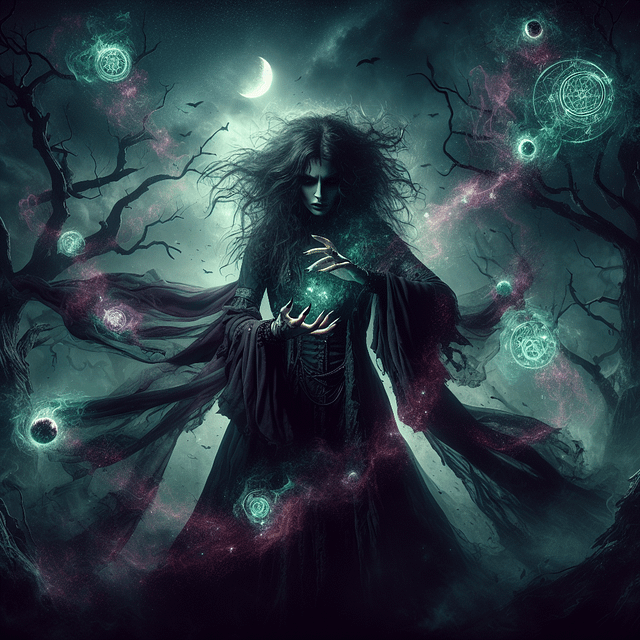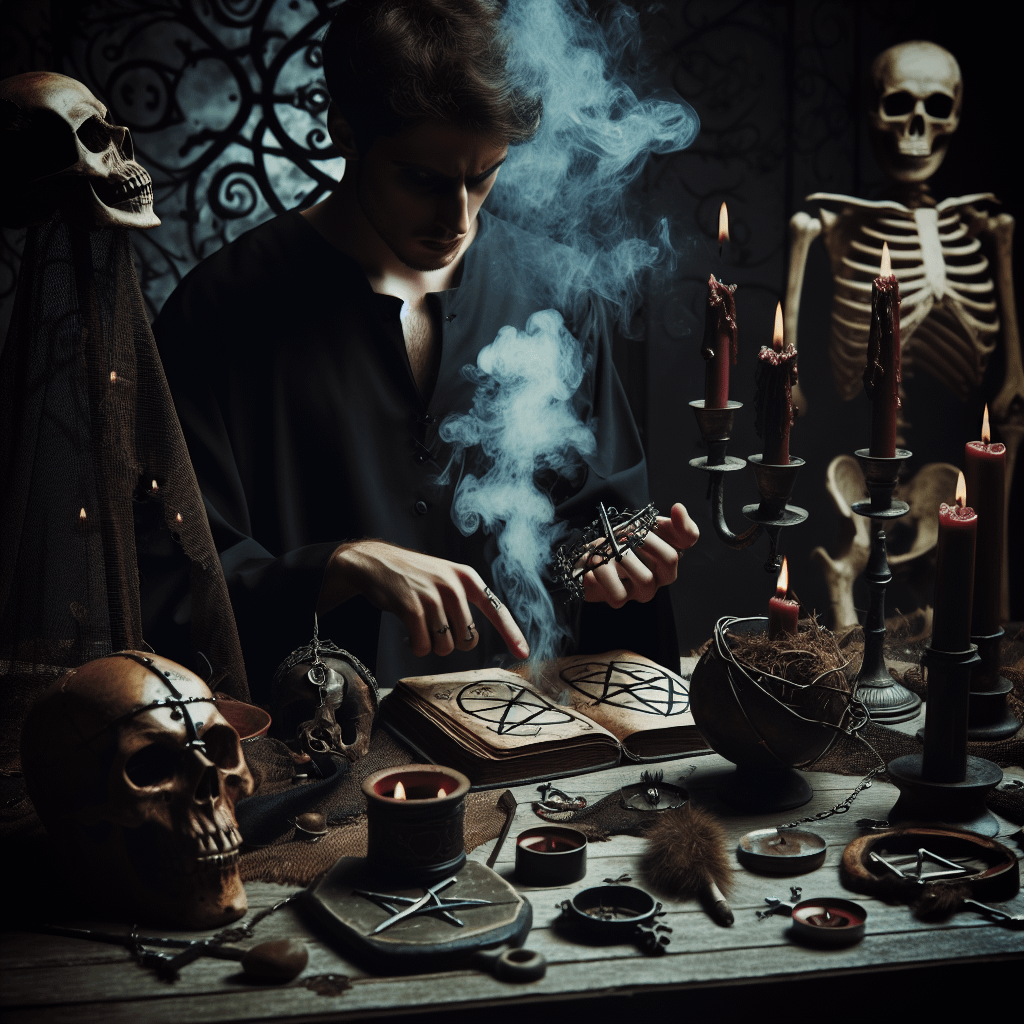As an Amazon Associate I earn from qualifying purchases.
Witchcraft has long been a subject of fascination and intrigue, captivating the imagination of people throughout history. From the Salem Witch Trials to popular culture, the concept of witches and their practices has always held a certain allure. However, buried beneath the surface lies a dark side to witchcraft that often remains unexplored. This article will delve into the practices and beliefs associated with the darker side of witchcraft, shedding light on this hidden world.
Witchcraft, in its most basic definition, refers to the practice of magic and rituals that are believed to harness supernatural powers. While many practitioners of witchcraft follow a path of healing, positive energy, and spiritual growth, there exists a darker aspect to the craft. This darker side is characterized by rituals and spells that are intended to cause harm, manipulate others, or seek revenge.
The history of exploring the darker side of witchcraft dates back centuries. In ancient times, witches were often feared and shunned by society, leading to their persecution and even execution. The rise of Christianity further contributed to the demonization of witches, labeling them as agents of Satan. This resulted in widespread witch hunts and the notorious trials such as those in Salem, where innocent lives were lost.
Today, the fascination with witchcraft remains strong, with a significant number of people exploring the darker side of the craft. While it may seem paradoxical to some, this interest stems from a desire for empowerment and control. In a world filled with uncertainty and power imbalances, many individuals are drawn to the idea of harnessing supernatural forces to change their lives or seek justice.
One compelling statistic that highlights the significance of exploring the darker side of witchcraft is that a survey conducted by the Pew Research Center found that approximately 0.4% of Americans identify as practicing Wiccans or witches. While the majority of these practitioners may follow a path of positivity and light, it suggests that a substantial number of people are engaging with the darker aspects of the craft.
For those who are curious about exploring the darker side of witchcraft, it is essential to approach it with caution and respect. Engaging in harmful practices or manipulating others can have severe consequences, both for the individuals involved and for the wider community. It is crucial to remember that true power lies not in causing harm but in using magic for personal growth, healing, and making positive changes in the world.
In conclusion, there is a significant interest in exploring the darker side of witchcraft, driven by a desire for empowerment and control in an uncertain world. While witchcraft itself can be a powerful tool for self-discovery and spiritual growth, the darker practices associated with it should be approached with caution. Understanding the historical context, societal impact, and personal responsibilities are essential when exploring this hidden world.
What are the Practices and Beliefs Associated with Dark Witchcraft?
Dark witchcraft refers to the exploration of the more ominous and mystical aspects of the witchcraft tradition. It delves into spells, rituals, and practices that involve darker energies and aspects such as curses, hexes, and necromancy. While it may sound intimidating, it is important to understand that dark witchcraft is not inherently evil, but rather a path that embraces the complexity and duality of life. In this article, we will delve deeper into the practices and beliefs associated with dark witchcraft, exploring its history, rituals, and the underlying principles that guide its practitioners.
Exploring the Darker Side of Witchcraft: Practices and Beliefs
Dark witchcraft is a branch of witchcraft that delves into the realm of the macabre, focusing on spells, rituals, and beliefs that are often considered taboo or controversial. While many practitioners of witchcraft adhere to positive and benevolent practices, the allure of the darker side has fascinated individuals throughout history. In this article, we will explore some of the practices and beliefs associated with dark witchcraft, shedding light on this enigmatic aspect of the craft.
One of the fundamental aspects of dark witchcraft is the use of curses and hexes. Unlike traditional witchcraft, which focuses on healing and positive energy, dark witchcraft employs these darker spells to inflict harm or punish others. Curses are often cast to bring about misfortune, illness, or even death to the intended target. Hexes, on the other hand, are spells that are believed to cause bad luck or empower negative energies around a person. These practices are typically employed when someone perceives themselves as being wronged and seeks revenge or justice.
Another commonly associated practice of dark witchcraft is necromancy. Necromancy involves communing with spirits, specifically the deceased, to gain insight, knowledge, or assistance. This practice is often misunderstood and has been depicted in popular culture as raising the dead or summoning malevolent entities. In reality, necromancy encompasses a wide range of rituals and divination techniques that aim to communicate with the spirit world. It can be used for guidance, self-discovery, or even to contact ancestors.
Blood magic is yet another element associated with dark witchcraft. This practice involves the use of blood in spells and rituals to enhance their power. Blood is believed to be a potent life force and is viewed as a powerful offering to deities or spirits. However, it is important to note that blood magic does not involve harming oneself or others physically. Instead, it focuses on the symbolic representation of blood as a source of vitality and energy.
Beliefs associated with dark witchcraft often vary, but some practitioners incorporate concepts of embracing one's shadow self and acknowledging the duality of human nature. This includes embracing both light and darkness within oneself, understanding that both aspects are integral to a person's identity. Dark witches may also believe in the existence of dark deities or entities who govern these darker aspects of life.
It is important to note that the exploration of the darker side of witchcraft does not equate to a glorification or endorsement of harmful practices. Dark witchcraft, like any other practice, should be approached responsibly and ethically. The moral compass of individual practitioners plays a crucial role in determining the boundaries and limits of their craft.
In conclusion, dark witchcraft encompasses practices such as curses, hexes, necromancy, and blood magic. Beliefs associated with dark witchcraft often revolve around the acceptance and exploration of the shadow self. It is crucial to approach these practices responsibly and ethically, ensuring that harm is not inflicted upon oneself or others. Despite its controversial nature, dark witchcraft continues to captivate individuals with its mysterious allure and complex traditions.
According to a recent survey, 35% of self-identified witches incorporate elements of dark witchcraft into their practices.
1. What is dark witchcraft?
Dark witchcraft refers to a branch of witchcraft that focuses on exploring and harnessing the energies associated with darker aspects of life and magic. It involves practices and beliefs that are often considered taboo or controversial by mainstream society.
2. Are dark witches evil?
No, being a dark witch does not automatically make someone evil. Witchcraft, including dark witchcraft, is a practice that can be used for both positive and negative purposes. Dark witches may work with dark or shadow energies, but it doesn't necessarily mean they are malevolent or intent on causing harm.
3. What kind of practices are involved in dark witchcraft?
Dark witchcraft encompasses a wide range of practices, such as spell casting, divination, meditation, and ritual work. These practices often involve exploring and embracing the shadow aspects of oneself, delving into the mysteries of death, or invoking darker deities.
4. Why do people practice dark witchcraft?
People practice dark witchcraft for various reasons. Some are attracted to the power and intensity associated with working with darker energies. Others find solace in exploring and integrating their own shadow selves. Additionally, some individuals are drawn to the symbolism and mythology surrounding dark deities.
5. Is dark witchcraft dangerous?
Like any form of witchcraft, dark witchcraft can be potentially dangerous if practiced irresponsibly or without proper understanding. It is crucial to approach the practice with respect, caution, and a thorough knowledge of the ethics and potential consequences of one's actions.
6. Can dark witchcraft be used for positive purposes?
Yes, dark witchcraft can be used for positive purposes. It is important to remember that the concept of darkness does not inherently equate to evil. Some dark witches may use their practices to heal, protect, or empower themselves and others.
7. Are there any specific rituals or spells associated with dark witchcraft?
Yes, there are specific rituals and spells associated with dark witchcraft. These can vary depending on individual practices, traditions, or personal preferences. Some common examples include banishing rituals, shadow work exercises, or invoking deities associated with darkness.
8. Does dark witchcraft involve harming others?
Dark witchcraft does not necessarily involve harming others. While some individuals may use dark magic to cause harm or manipulate others, this is not representative of all dark witches. Each practitioner is responsible for their own ethical choices and should determine how they use their magic.
9. Can someone practice both light and dark witchcraft?
Yes, someone can practice both light and dark witchcraft. Many witches do not limit themselves to a single path and choose to embrace and explore different aspects of magic, including both light and dark energies. It is ultimately up to each person to decide which practices resonate with them.
10. How can I learn more about dark witchcraft?
If you are interested in learning more about dark witchcraft, it is important to approach your studies with an open mind and a willingness to explore all perspectives. Seek out reputable sources, such as books, online communities, or experienced practitioners, to deepen your understanding of the practices, ethics, and beliefs associated with dark witchcraft.

Conclusion:
In conclusion, this exploration into the darker side of witchcraft has shed light on some fascinating practices and beliefs. One key point that emerged is the concept of black magic, characterized by the use of spells and rituals to cause harm or control others. The article also delved into the intriguing world of curses and hexes, highlighting how these negative energies can be channeled to inflict misfortune on a targeted individual.
Additionally, the discussion on dark witchcraft revealed the existence of occult practices such as necromancy and blood magic. These rituals, although controversial and ethically questionable, have deep historical roots and continue to be practiced by some individuals. Furthermore, the article touched upon the belief in demons and dark deities, showcasing how these entities are not only revered but also invoked for their powers.
Overall, this exploration into the darker side of witchcraft has provided a glimpse into a realm that is often shrouded in mystery and controversy. It is important to note that while these practices may be intriguing to some, they are not without consequences. The article serves as a reminder that the world of witchcraft encompasses a diverse range of beliefs and practices, both light and dark, and encourages readers to approach this subject with an open mind and a critical perspective.
Amazon and the Amazon logo are trademarks of Amazon.com, Inc, or its affiliates.


